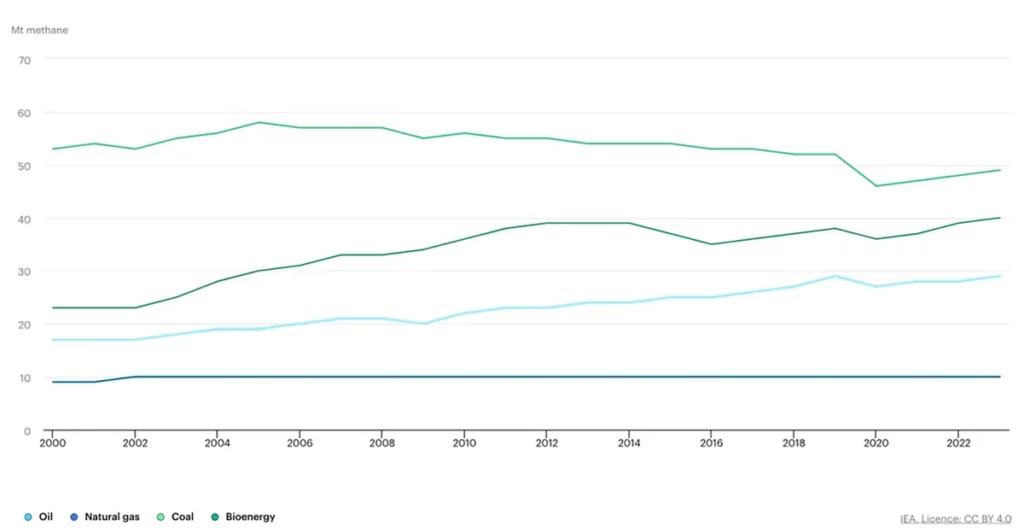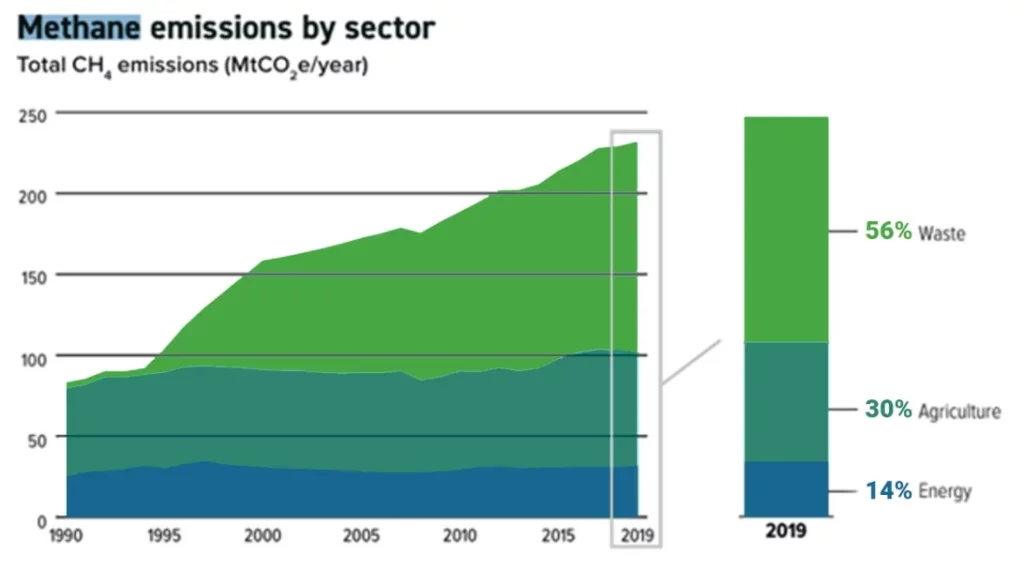Methane Matters:
Addressing Indonesia's Methane Challenges
Overview of Methane Emissions, Key Sectors, Policy Landscape, and Actionable Steps for a Sustainable Future
Methane
Methane (CH4) is a potent greenhouse gas with a shorter atmospheric lifetime than CO2. While naturally occurring, anthropogenic activities, primarily in agriculture, fossil fuels, and waste, have significantly increased methane emissions. The fossil fuel sector, accounting for over one-third of global anthropogenic methane emissions, is a major contributor. Although it has a shorter atmospheric lifespan, methane’s greater heat-trapping ability makes it a major contributor to global warming. Its impact is amplified by its role in the formation of ozone, another greenhouse gas, and indirectly negative influences on human health, crop productivity, and vegetation.
Methane emissions from fossil fuels have been identified as one of the main contributors, around 24% globally. While these emissions were estimated to increase by 17% between 2020 and 2030 (Global Methane Initiative, 2022), recent data from the IEA (2024) shows that since 2019, when emissions in the energy sector reached a record high, they have remained at that level (Figure 1).
Indonesia's Methane Challenge: A Call for Action in Energy and Trade
One of the biggest challenges facing Indonesia, a country rich in natural resources and one of major players in Southeast Asia’s energy market, is reducing its substantial methane emissions. Methane emissions, one of the leading causes of global warming, must be addressed immediately and comprehensively. Shidiq, one of the speakers, discussed the GHG issue in Indonesia in general, and methane emissions in particular. He described the sources of methane, the obstacles associated with reducing methane, and the activities that can be taken to reduce methane emissions in Indonesia.
A Rising Tide of Methane Emissions
In general, methane emissions in Indonesia are increasing. If methane emissions from land use, land use change and forestry (LULUCF) are excluded, Indonesia’s methane emissions increased significantly by 180% or to 232 MtCO2e/year between 1990 and 2019. The waste sector is the largest contributor to methane emissions at around 56%, followed by the agricultural sector (30%) and the energy sector (14%). This fact underscores the importance of taking comprehensive actions and decisions to reduce methane emissions from all sources in the sector.
Unpacking the Sources: Key Sectors and Challenges
Several key sectors in Indonesia significantly contribute to methane emissions, each presenting unique challenges as follows:
Oil and gas. Major sources of methane leakage are extraction, refinery, and transportation of oil and gas. Improved infrastructure upkeep, the use of cutting-edge Leak Detection and Repair (LDAR) technologies, and the capture of fugitive emissions are all required for minimizing the emission.
Coal. Methane is released during the mining, processing, transporting and use of coal, frequently as a result of inefficient methods and inadequate capture technology. To reduce these emissions, additional investment must be spent in measuring and monitoring methane emissions in coal-related sectors.
Waste. Methane emissions from this sector are strongly influenced by waste management, especially at landfills. Implementing a more environmentally friendly waste management system, such as processing waste into renewable energy and anaerobic waste digestion, can reduce methane emissions.
Agriculture. Raising livestock, especially cows, can produce quite large methane emissions. Reducing emissions from this sector can be achieved by implementing strategies such as better manure management and feed quality.
Policy Landscape: Progress and Opportunities
Indonesia realizes the importance of methane gas mitigation, therefore the policy landscape related to methane continues to develop, such as:
The Global Methane Pledge. Indonesia’s commitment to the Global Methane Pledge, which aims to reduce methane emissions by at least 30% of 2020 levels by 2030, provides an important framework for taking action. However, concrete implementation plans and strong enforcement mechanisms are essential to achieve this ambitious goal.
Minister Regulation of Energy and Mineral Resources No. 22/2019. This regulation, outlining guidelines for inventorying and mitigating greenhouse gasses including methane in the energy sector, is a positive step. However, ensuring effective and comprehensive implementation to achieve tangible emissions reductions requires further attention.
Collaboration with International Partners. Indonesia is already in partnership with international organizations, including Japan Organization for Metals and Energy Security (JOGMEC), focused on measuring and estimating methane emissions at natural gas production facilities, providing valuable expertise and resources. Understanding the importance of leveraging the international collaborations for comprehensive methane mitigation strategies, ECADIN is working with stakeholders such as Pertamina to develop a joint research project and / or collaboration to measure and monitor methane emissions.
Charting a Path Forward: Actionable Steps for Indonesia
Effectively addressing methane emissions requires a multi-faceted approach involving a strong policy framework, technological innovation and capacity building as follows:
National Methane Roadmap Development. Developing the national roadmap with an objective, action plan, strategies and clear targets and objectives to set methane reduction, is a critical step. Another step may also build international cooperation with international development partners and donors that are able to provide valuable input, knowledge and shared expertise.
Sector-Specific Policies. Implementing specific policies and regulations tailored to reduce methane emissions in specific sectors such as the oil and gas sector is very important. Examples include regulations for leak detection and repair (LDAR) in the oil and gas industry, methane capture technology in coal facilities, and improved waste management practices.
Incentivize and Advanced Technology for Reducing Methane Emission. Introducing financial incentives for sectors aimed at reducing methane emissions as well as adopting advanced methane reduction technologies can play an important role in accelerating the reduction of methane emissions.
Capacity Building. Capacity building programs for policymakers, regulators and industry professionals to increase their knowledge and skills regarding methane gas mitigation are essential to ensure successful implementation and long-term sustainability.
Conclusion
The significant increase in methane emissions in Indonesia and the challenges that exist to reduce methane emissions are facts that must be faced and resolved. However, these existing challenges also present opportunities to leverage national, regional and international resources and partnerships to transition methane reduction in the future. Developing a roadmap with a comprehensive action plan, developing sector-specific policies, and collaborating with national and international partners to significantly reduce methane emissions are important steps that must be implemented so as to contribute to global efforts to mitigate climate change. Now is the time to act.




